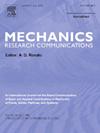基于应变能分解的人类股骨区域特异性骨重构的计算分析
IF 2.3
4区 工程技术
Q3 MECHANICS
引用次数: 0
摘要
本文提出了一种适用于二维人体股骨的骨重构有限元模型。基于先前的工作,该模型区分了流体静力应变能和偏应变能分量,以模拟它们各自对重塑刺激的贡献。研究了三种生理上相关的加载条件——肌肉加载、弯曲-扭转和扭转——以确定局部机械刺激如何影响骨量密度、体积模量和剪切模量的演变。我们的研究结果表明,重塑反应具有很强的区域特异性,并且取决于机械载荷的方式和强度。在肌力作用下,能量集中和重塑活动局限于股骨颈和骨干中段。扭转载荷产生较大的偏能场,特别是在股骨干和颈部,导致剪切模量增加。通过与先前的圆形和方形几何模型的比较,验证了该模型对应变模态的敏感性,同时揭示了由于真实骨骼结构引起的额外不对称。这些发现为功能适应性提供了机制洞察,并为患者特定骨折风险评估和治疗计划提供了计算基础。本文章由计算机程序翻译,如有差异,请以英文原文为准。
Computational analysis of region-specific bone remodeling in the human femur via strain energy decomposition
This paper proposes a finite element model of bone remodeling that is applied to a two-dimensional human femur. Based on previous works, the model distinguishes between hydrostatic and deviatoric strain energy components in order to mimic their respective contributions to the remodeling stimulus. Three physiologically relevant loading conditions — muscular loading, bending-torsion, and twisting — were investigated to determine how localized mechanical stimuli affect the evolution of bone mass density, bulk modulus, and shear modulus. Our results indicate that remodeling responses are very region-specific and depend on both the manner and intensity of mechanical loading. Under muscular force, energy concentrations and remodeling activity were restricted to the femoral neck and mid-diaphysis. Torsional loads created larger deviatoric energy fields, particularly in the femoral shaft and neck, resulting in increased shear modulus. The model’s sensitivity to strain mode was validated by comparison with prior simulations on circular and square geometries, while additional asymmetries due to realistic bone structure were revealed. These findings give mechanistic insight into functional adaptability as well as a computational underpinning for patient-specific fracture risk assessments and treatment planning.
求助全文
通过发布文献求助,成功后即可免费获取论文全文。
去求助
来源期刊
CiteScore
4.10
自引率
4.20%
发文量
114
审稿时长
9 months
期刊介绍:
Mechanics Research Communications publishes, as rapidly as possible, peer-reviewed manuscripts of high standards but restricted length. It aims to provide:
• a fast means of communication
• an exchange of ideas among workers in mechanics
• an effective method of bringing new results quickly to the public
• an informal vehicle for the discussion
• of ideas that may still be in the formative stages
The field of Mechanics will be understood to encompass the behavior of continua, fluids, solids, particles and their mixtures. Submissions must contain a strong, novel contribution to the field of mechanics, and ideally should be focused on current issues in the field involving theoretical, experimental and/or applied research, preferably within the broad expertise encompassed by the Board of Associate Editors. Deviations from these areas should be discussed in advance with the Editor-in-Chief.

 求助内容:
求助内容: 应助结果提醒方式:
应助结果提醒方式:


